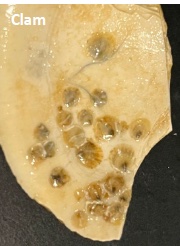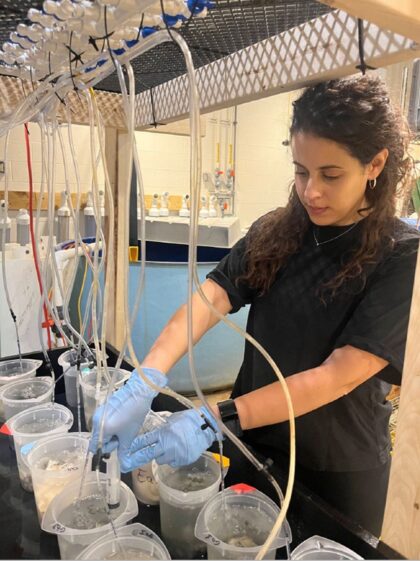It’s hard to say something nice about viruses, but Dr. Joaquín Martínez Martínez can. Dr. Martínez Martínez is a new aquatic virus ecologist at Horn Point who studies how viruses interact with acceptable host cells (typically each virus targets only a single host cell type). He studies how those interactions are influenced by environmental conditions and correspondingly, how these interactions impact the environment.
When we think of viruses, we think of COVID 19, HIV, influenza, Herpes, Shingles, Measles and a suite of viruses that cause discomfort and loss of life. But there are more to viruses than human infections. For one, viruses are the most abundant life forms on Earth, able to live in all environments. They have the ability to remain dormant for long periods until they find a host to infect. Viruses are the most abundant biological entities in the oceans, lakes, soil, and shallow sediments, far exceeding the number of bacteria.
There are so many viruses that the majority of viruses remain unidentified. This is due to their microscopic size and their complexity. However, advancements in omics—techniques that analyze genetic material recovered directly from environmental samples—have revolutionized the field. Omic tools enable scientists to discover new viruses without having to culture them in a lab.
The evolutionary history of viruses is not known, but there are theories. One theory is that viruses, or their precursors, may have evolved before other forms of life. This hypothesis suggests that viruses could have played a crucial role in the development of cellular life. The simplicity of their structure, combined with their ability to transfer genetic material, implies that viruses may have been integral to the evolution of complex organisms.
We know viruses as causes of diseases, but they are also active participants in the evolutionary process of their hosts. Through a mechanism known as horizontal gene transfer, viruses can transfer genes into the host, contributing to genetic diversity and evolution. Some of the genes that viruses have inserted into our DNA millions of years ago are now essential for cellular functions. Other viruses help by maintaining the balance of bad bacteria, even in our gut. Viruses exist in the ecosystem, in plants, animals, humans and because of their specificity they help the organisms that carry them by infecting and killing pathogens.
Gene transfer can also occur when the virus gets DNA from the host cell. Viruses can carry key genes from the host even if the host shuts down the infection, then virus can beat the host cell because it is carrying some host’s DNA.
To understand viruses, it is important to understand that viruses very selectively target host cells; generally speaking, each virus can only infect a single type of host cell (e.g., a certain virus can only attack a certain bacteria). Viruses are not alive until they enter a host cell and hijack the host cell metabolism and nutrients to reproduce. Often, the virus kills the host cell through a process called lysis where the host cell “bursts” spewing out its contents into the system (e.g., aquatic system, our bloodstream).
Other times, viruses can co-exist for extended times with the host without killing it, for example inserting their genetic material into the host cell’s genetic material. When the host cell makes copies, the virus DNA is duplicated. This viral DNA often remains dormant in the cell, until it becomes activated. An example that we are familiar with is the HIV virus, which remains dormant in the cells until it expresses itself as full blown AIDS.
Viruses play a vital role in regulating the ecosystems of our rivers and seas. The largest type of aquatic viruses are bacteriophages, which attack bacteria. Viruses can control bacterial populations and algae blooms. In marine environments, viruses are responsible for the lysis (breaking down) of a significant fraction of the bacterial population each day, releasing nutrients back into the ecosystem and supporting the food web. When a cell breaks down in lysis, the contents of the cell (including nutrients) are injected into the environment. This is called nutrient cycling, and it helps maintain ecological equilibrium.
Dr. Joaquín Martínez Martínez has been studying red tide algae blooms in the Gulf of Mexico, which can have devastating consequences. The algae produce toxins that can kill fish, marine mammals, birds, and other marine life. Red tide algae blooms can lead to massive die-offs and disrupt the ecosystem.
Dr. Joaquín Martínez Martínez and other scientists are studying the microbes (e.g., viruses, bacteria, algae), nutrients, temperature, currents, tides, and microbial interactions to determine the causes and preconditions for these blooms. Scientists need to determine which viruses and bacteria can be helpful in prevention and control. The current goal is to be able to forecast the conditions when a red tide algae bloom will occur and provide an early warning. Eventually, they hope to be able to use viruses and bacteria in the ecosystem to regulate these devastating red tide algae blooms. In his new position at Horn Point Laboratory, he is hoping to translate what he and his colleagues are learning from this study to harmful blooms around the Chesapeake Bay.
When hosts are virally infected, they become a virtually different organism. For example, due to chemical changes induced by the infection, one phytoplankton species becomes more nutritional when infected with a certain virus. This extra nutrition enables other organisms to grow faster when feeding on this infected phytoplankton. Other phytoplankton species can take more CO2 from the environment when infected with their specific viruses. Scientists are studying such phenomena under natural conditions so that they can assess its impact and determine how to maintain the balance that is currently in nature. Is it scalable? Research is investigating this because it has a potential to remove carbon from the atmosphere or improve feed production for aquaculture.
Horn Point has recognized the potential of viruses in the ecosystem for its research in the Chesapeake Bay and its tributaries. Dr. Joaquín Martínez Martínez’s intends to create partnerships and collaborate with scientist that study aquatic vegetation and oyster populations. He has currently proposed a study of marshes on Poplar Island. Marshes are critical to the shoreline and ecosystem, yet sometimes they die suddenly, and scientists need to know why and what are the roles of microbes in these deaths.
So, despite our negative perception of viruses, Dr. Joaquín Martínez Martínez wants us to know that viruses are not necessarily the bad guys. Viruses, in fact, create balance, especially against bacteria that are detrimental to us and the environment. Viruses can be helpful in medicine. Since they are mostly specific to a host, they may become an alternative to antibiotics. Additionally, viruses are used as markers in gene therapy to deliver therapeutic genes to target cells. Oncolytic viruses, which selectively infect and kill cancer cells, are offering new hope in cancer treatment. Environmental viruses may serve as innocuous surrogates to safely deliver those treatments to humans.
The viruses that we hate are the tiniest, tiniest fraction of the viruses in the world…maybe it’s time we cast them as players in the environment rather than demons.
Dr. Joaquín Martínez Martínez will be discussing his research on February 27th at 5:30 at the Dorchester Center for the Arts, 321 High Street, Cambridge. Check the Horn Point Laboratory website, www.umces.edu/hpl or their social media for more information about registration.
Angela Rieck, a Caroline County native, received her PhD in Mathematical Psychology from the University of Maryland and worked as a scientist at Bell Labs, and other high-tech companies in New Jersey before retiring as a corporate executive. Angela and her dogs divide their time between St Michaels and Key West Florida. Her daughter lives and works in New York City.




 The iridescent blue wings of the male Blue Morpho butterflies have long fascinated people and scientists. The Blue Morpho does not use pigment to create its bright blue iridescent color on its wings. Rather than absorb and reflect certain light wavelengths as pigments and dyes do, their wings have a layered microstructure that causes light waves to hit the surface of the wing to diffract and interfere with each other so that certain color wavelengths cancel out while others, such as blue, are intensified and reflected. The Morpho’s colors are a structural color, reflecting only blue light due to the wings’ unique nanostructure. At the University of Rochester, researchers are studying this phenomenon to develop light-absorbing materials for solar panels. By mimicking the Morpho butterfly’s nanostructure, they can create an absolute black which will increase solar panel efficiency by 130%.
The iridescent blue wings of the male Blue Morpho butterflies have long fascinated people and scientists. The Blue Morpho does not use pigment to create its bright blue iridescent color on its wings. Rather than absorb and reflect certain light wavelengths as pigments and dyes do, their wings have a layered microstructure that causes light waves to hit the surface of the wing to diffract and interfere with each other so that certain color wavelengths cancel out while others, such as blue, are intensified and reflected. The Morpho’s colors are a structural color, reflecting only blue light due to the wings’ unique nanostructure. At the University of Rochester, researchers are studying this phenomenon to develop light-absorbing materials for solar panels. By mimicking the Morpho butterfly’s nanostructure, they can create an absolute black which will increase solar panel efficiency by 130%.

 But it is important to know which substrates perform most effectively. Drs. Elizabeth North, Matt Gray, and Monica Fabra at University of Maryland Center for Environmental Science Horn Point Laboratory (HPL) are evaluating the efficacy of 9 different substrates. They are scientists with expertise in marine biology and experience with research on oysters.
But it is important to know which substrates perform most effectively. Drs. Elizabeth North, Matt Gray, and Monica Fabra at University of Maryland Center for Environmental Science Horn Point Laboratory (HPL) are evaluating the efficacy of 9 different substrates. They are scientists with expertise in marine biology and experience with research on oysters.  The 9 substrates are: (1) dredged Eastern oyster shells, (2) weathered Pacific oyster shells, (3) clam shell pieces, (4) whelk shells,(5) recycled concrete, (6) limestone marl, (7) granite, (8) river rocks, and (9) amphibolite. Fresh Eastern oyster shell (our Maryland oyster) was also used in the study.
The 9 substrates are: (1) dredged Eastern oyster shells, (2) weathered Pacific oyster shells, (3) clam shell pieces, (4) whelk shells,(5) recycled concrete, (6) limestone marl, (7) granite, (8) river rocks, and (9) amphibolite. Fresh Eastern oyster shell (our Maryland oyster) was also used in the study. She and her team are also evaluating these substrates to verify that they do not leach heavy metals. Another evaluation will be related to the formation of biofilms that are important for larval settlement on substrate.
She and her team are also evaluating these substrates to verify that they do not leach heavy metals. Another evaluation will be related to the formation of biofilms that are important for larval settlement on substrate.